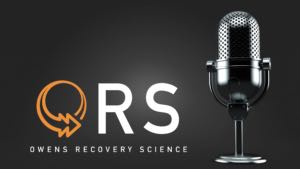BFR & IPC FOR PERFORMANCE, REHAB, AND HEALTH w/ JAMIE BURR, PhD
In this episode Johnny and Kyle chat with Dr. Jamie Burr, Director of the Human Performance & Health Research Laboratory at the University of Guelph. During this podcast we discuss Dr. Burr and his lab’s work centering on ischemic preconditioning, and blood flow restriction exercise and how it can be used to address the exercise needs of the elite level athlete to person’s managing chronic disease like diabetes. We’re certain you’ll enjoy this chat! Check out the full podcast here.
If you have questions or a topic that you want to hear about, you can submit the topic or question through info@owensrecoveryscience.com with the subject line #podcast. If your question/topic gets selected, you can receive a free ORS shirt.
Here’s some of the references we discussed during the podcast:
Pignanelli, C., Christiansen, D., & Burr, J. F. (2021). Blood flow restriction training and the high-performance athlete: science to application. Journal of Applied Physiology. doi.org/10.1152/japplphysiol.00982.2020
Bjørnsen, T., Wernbom, M., Kirketeig, A., Paulsen, G., Samnøy, L., Bækken, L., Cameron-Smith, D., Berntsen, S., & Raastad, T. (2018). Type 1 Muscle Fiber Hypertrophy after Blood Flow-restricted Training in Powerlifters. Medicine and Science in Sports and Exercise. doi.org/10.1249/MSS.0000000000001775
Ferguson, R. A., Mitchell, E. A., Taylor, C. W., Bishop, D. J., & Christiansen, D. (2021). Blood-flow-restricted exercise: Strategies for enhancing muscle adaptation and performance in the endurance-trained athlete. Experimental Physiology. doi.org/10.1113/EP089280
Morley, W. N., Coates, A. M., & Burr, J. F. (2020). Cardiac autonomic recovery following traditional and augmented remote ischemic preconditioning. European Journal of Applied Physiology. doi.org/10.1007/s00421-020-04526-y
Petrick, H. L., Pignanelli, C., Barbeau, P.-A., Churchward-Venne, T. A., Dennis, K. M. J. H., van Loon, L. J. C., Burr, J. F., Goossens, G. H., & Holloway, G. P. (2019). Blood flow restricted resistance exercise and reductions in oxygen tension attenuate mitochondrial H2 O2 emission rates in human skeletal muscle. The Journal of Physiology. doi.org/10.1113/JP277765
Dr. Burr discussing the work his lab does: www.youtube.com/watch?v=oz0A4M8ajc4&t=98s
Cheung, C. P., Slysz, J. T., & Burr, J. F. (2019). Ischemic Preconditioning: Improved Cycling Performance Despite Nocebo Expectation. International Journal of Sports Physiology and Performance, 1–22.
Jean-St-Michel, E., Manlhiot, C., Li, J., Tropak, M., Michelsen, M. M., Schmidt, M. R., McCrindle, B. W., Wells, G. D., & Redington, A. N. (2011). Remote preconditioning improves maximal performance in highly trained athletes. Medicine and Science in Sports and Exercise, 43(7), 1280–1286.
Crisafulli, A., de Farias, R. R., Farinatti, P., Lopes, K. G., Milia, R., Sainas, G., Pinna, V., Palazzolo, G., Doneddu, A., Magnani, S., Mulliri, G., Roberto, S., & Oliveira, R. B. (2018). Blood Flow Restriction Training Reduces Blood Pressure During Exercise Without Affecting Metaboreflex Activity. Frontiers in Physiology, 9, 1736.




